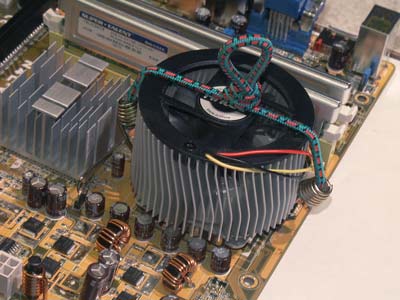|
World Conquest
May, 2007 | ||||||
| Sun | Mon | Tue | Wed | Thu | Fri | Sat |
| 1 | 2 | 3 | 4 | 5 | ||
| 6 | 7 | 8 | 9 | 10 | 11 | 12 |
| 13 | 14 | 15 | 16 | 17 | 18 | 19 |
| 20 | 21 | 22 | 23 | 24 | 25 | 26 |
| 27 | 28 | 29 | 30 | 31 | ||

because ... well ... why not ...?
it's a dirty job, but somebody's got to do it.
- Friday May 18th
- 19:54PM
- 19:54PM
- Cover Story:

(the front cover of
The Shadow Walkers)I got a slightly early copy of the official Lionsgate DVD release of The Shadow Walkers today, just ahead of its official release this coming Tuesday.
I'd been curious what it would look like, ever since I saw the rather puzzling cover picture in the ads for it. Puzzling, because it bears no resemblance to anything or anybody in the movie.
Not that it's such a bad picture, mind you. It might make a fine cover for the movie that it's from, but it was a little odd to see it in the ads for The Shadow Walkers. It wouldn't be the first time that Lionsgate has used a "cover picture" in their ads that turned out to be different from the actual DVD cover, so I was really wondering what the DVD would look like when I finally got my hands on one.
But the cover was its same puzzling self as I'd seen in the ad and, furthermore, checking out the back cover and the DVD menus, there were absolutely none of the promotional stills or artwork that had been created for the movie to be found. There's an artist's drawing--and a pretty good one, to be sure--that at least is closer to the content of the movie--on the back, but the DVD menus and the spine of the DVD feature instead the same woman who's pictured on the front cover.
At this point, it wouldn't be surprising if you were wondering who this mysterious woman is and where the picture came from.
Back when The Shadow Walkers was in production, Shoreline Entertainment also had their fingers in on another, similarly-titled production, Shadow Puppets, starring Jolene Blalock It takes place in a mental asylum where she is tormented by shadowy apparitions and spectral terrors. Near as I can tell, the cover image on The Shadow Walkers is an artist's rendering from Shadow Puppets, so my leading theory at the moment--since none of the photographs or graphics from The Shadow Walkers seem to have made it into Lionsgate's DVD designers' hands--is that the helpful folks at Shoreline delivered the wrong collection of graphics along with the master tapes when they were creating the DVD.

(the back cover of
The Shadow Walkers)
I suppose you can see how such an error could occur--after all, the materials might have been right next to each other on the shelf, what with that whole "alphabetical order" thing and all--but what is amazing is that apparently nobody noticed.
As it happened, apparently Shoreline was aware of how easily they mix these things up at the time, because they wanted us to change the title of The Shadow Walkers to avoid this kind of confusion. Trouble is, the title they wanted was "Mutant Warriors" which our production team was less than enamored with. So "The Shadow Walkers" it remained and, well, now we know why they were worried.
Still, it's kind of like releasing a new edition of Full Metal Jacket using pictures from The Full Monty for the DVD cover and the menus. Sure, they are both have the word "full" in them and they are both about a group of men, but they really aren't the same. How do you get through the DVD authoring process, setting up the chapters and buttons for them, and putting it all together without ever noticing that you've been working on a different movie?

(okay...I guess I can understand that a lot of people would probably rather look at Jolene Blalock than me, but, still....)Well, every day is a new learning experience about how the movie industry works--and I certainly have been through enough such learning experiences to be amazed that it works at all. Weird cover choice or not, I'm still pretty darned happy to see The Shadow Walkers out and in the stores. Can't you tell from my cheerful mug to the left?
- Tuesday May 15th
- 19:12PM
- Back in Black:
I finally got my copy of Backslash: The Ultimate Internet Predator and there I am, right on the back cover.
Well, you might not recognize me right off, but I'm the one on the lower left.
I suppose it's an imperfect compliment: "we'd like to feature you on the videotape cover. ...um, but put this bag over your head first." You'd think I was on a date or something.
Bag-over-my-head or not, I'm still pretty happy about it. Sure, I've been on other DVD covers before, but not so many that I'm not pretty thrilled to add to that list.

(the back cover of Backslash)

(oh, no! I have "hood hair.")And at least you can probably tell that it's my eyeball on there.
- Sunday May 13th
- 11:18AM
- Watt's Up?
So yesterday I was lifting big, heavy things and then resting between sets by powering up an assortment of CPU and motherboard combinations and measuring their power consumption. Typical activity here at the treehouse.
I picked up a P3 International Kill-A-Watt Power Meter for measuring the power consumption at the outlet and, apart from the motherboard, CPU, and memory, the only thing hooked up is a DVD-rom with a Slackware Linux boot disk in it. For a power supply, I used a Macron MPT-400, not because it's especially good, quiet, or one that I would be likely to use in any of the new server or workstation machines--it's just been on my test bed since 400 watts was big for a power supply, so why waste one of the particularly good and quiet power supplies I've bought since just for testing purposes.

Oh, wait--this is not a P3 International Kill-A-Watt Power Meter I'm picking up hereI let the systems boot up and then logged in, but that's about it. Not a very stringent test, but a quick and dirty one. Maybe too dirty.
CPU Motherboard power consumption
(watts)Athlon x2 3800
(Energy efficient version)Asus M2A-VM 52 Core Duo T2300e Asus N4L-VM DH 50 1.1GHz Pentium III
(times two)Supermicro 370DLR 53 233MHz Pentium II Asus P2B
(plus Matrox Mystique 4Meg PCI Video Card)30
Which is really a lot tighter clustering than I would have expected. Even the big EATX Supermicro server board with 2Gig of ECC registered memory and 64-bit PCI-X slots doesn't require significantly more power with two PIII CPUs than the single Core Duo laptop CPU on a little, frill-free MATX motherboard that's theoretically intended to be a low-power platform. I ended up leaving the Supermicro dual-CPU system running for a few hours while I was working on other things and when I came back, it was then showing 45 watts of power consumption. I didn't go back and test what happened over similar spans of time with the other boards.
So my grand hopes for slashing the power consumption across the board on the servers out here might be a little dotted if not actually dashed--but it does look like "upgrading" lowlier machines like the DNS servers from Pentium-II platforms to even a mobile-on-desktop solution would increase rather than decrease power consumption, and the DNS servers just don't need that much oomph.
Unfortunately, I didn't have any of the hungrier system boards I've been using set up for easy testing on hand--I've got some dual Athlon MP boards and dual P-IV Xeon systems in service, but no extras just standing by already assembled with CPUs and ready for this test. For that matter, I have plenty of dual PIII Xeon systems and a couple of quad PIII Xeon systems that I could check out, too, but my enthusiasm hasn't grown to that level yet.
Because, at that point, I noticed an undesirable rattling and scraping sound coming from my own webserver (the one you're reading this off of) which, upon inspection, was suffering from a CPU cooling fan about to go out. I think it's an all-too-serious case of "if it's not broke, don't fix it" thinking that has resulted in the main webserver still being a dual 266MHz Pentium II system with 384 meg of memory. State of the art stuff...about ten years ago.
So I figure I'll turn in early and get up in the middle of the night to fix it. Except after I replace the CPU fan, it won't reboot--the power comes on and then immediately shuts off again. Strangely, it will power up as long as I disconnect one of the drives, so my first thought was that there was a short between the SCA-to-68-pin adapter on that particular hard drive.
But replacing that didn't help, nor did replacing the drive, nor the cable. After trying many combinations of swapped-out components, it finally turned out that replacing the power supply would allow it to boot up *with* all the drives connected whereas the old power supply would shut down after half a second unless one of the drives was disconnected.
So, now being able to reboot the webserver (which had been running for nearly a year since the last time I'd rebooted it--on a power supply that, according to the date on it, was from 1998), it let me know that one of the drives in the operating system array had failed. (Yes, it's still using an array of 1-gig narrow SCSI drives for the operating system.) Fortunately, I had five drives of the same model on hand to replace it with (even though I'd given away almost all the small SCSI drives in the last few years). Unfortunately, even though they were the same model, they were slightly newer drives and were 8 megabytes smaller than the older drives of that model. (Seagate likes to do this a lot. This apparently serves no purpose except to prevent you from using newer drives to replace the older drives in RAID arrays.)
Since the drives were 8 meg smaller, the RAID controller refused to use them and I finally found a drive in my spares cupboard that wasn't smaller--a 4.3 gig drive. So the smallest replacement drive that I had which the controller would accept was bigger than the enire array.
At which point I rebooted the system and found that the partition table of the data drive array had been overwritten with all zeros. So I ended up repartitioning, reformatting, and restoring that array. And now we're back.
So even if the newer and greater hardware I was testing yesterday isn't going to save a lot of power over my ten-year-old current webserver, maybe this is just nature's way of hinting that there may be other reasons to upgrade that box.
So how was your morning?
- Thursday May 10th
- 6:52AM
- Bikes and Bungees:
The weather has been more cooperative lately from a bike-riding standpoint. Not too hot, not too cold, and a general lack of unexpected blizzards and ice-storms. (Yeah, it's spring, these things pop up sometimes.) Unfortunately, the construction crews have been getting out to enjoy the weather just as much as the bikers. Most of the time Colorado has some of the best bike trails anywhere, including the Platter River Greenway bike trail which normally goes diagonally across Denver metro area following the path of the river and you only have to cross three streets in more than thirty miles.

Normally. This spring, however, every couple of miles the trail has been torn up or closed down because of some nearby construction project--none of which, as far as I can tell, actually involve improving or changing the bike trail itself; it looks like they're doing something unrelated nearby and figured they might as well tear up the trail while they're at it.
So instead of cruising along for twenty miles next to the river, you go two miles, get detoured up to the Baja Fresh restaurant parking lot, then get to wander around a while on city streets until you locate a way to get back to the next remaining intact section of bike trail. Maybe it's all a conspiracy to drum up food sales. Or help build the spirits of city drivers who were missing the excitement and adventure of all the cyclists trying to wend their way through the automobile traffic.
In the meantime, after sitting out the whole netburst/PIV architecture phase on the processor front, I've been thinking that it's probably a good time to do some upgrading of the systems around the treehouse.
Most of the servers have been running since the late 90's or early 2000's and they're starting to show their age. The server you're pulling this page off of is a formerly state-of-the-art 266MHz Pentium II processor sitting on a fabulous Intel LX chipset board. Despite their age, you can say a lot for the LX and BX chipsets--for an x86 platform they are pretty darned stable and don't eat a lot of electrical power, especially compared to some of the high-end Nvidia chipsets.
The candidate platforms I'm testing right now include a few AMD "Energy Efficient" low-power Athlon x2 systems, Intel Core 2 Duo desktop boards (which will probably get used only for the most demanding of tasks like email filtering; webserving is so easy on the CPU by comparison), and some mobile-on-desktop platforms like the Asus N4L-VM DH shown here:
I've tried a bunch of methods to secure various cooling systems to this board, but so far the most effective (though not most confidence-inspiring) is the bungee cord method shown above. Works great, but since I'm building machines that need to run 24 hours per day for five or ten years solid, I need to look into the MTBF ratings for bungee cords before putting anything like this into service.
- Wednesday May 9th
- 8:11AM
- Prices Slashed!
Yesterday was Tuesday, May 8th, the official DVD release date for Backslash: The Ultimate Internet Predator distributed for your viewing enjoyment by Central Park Media's new distribution arm, Below the Radar Films.
Speaking as someone who puts a lot of time and effort into keeping films above the radar, I think "Below the Radar Films" is an odd name for a distribution company, but the fact of the matter is that I'm seeing Backslash available in most of the big-name online DVD stores and at least the online versions of the major brick-and-mortar stores (Best Buy, Circuit City, Barnes and Noble, etc.)--so they're doing a decent enough job of lifting their films above the radar.
The other title in their lineup (like I said, it's a brand-new distribution company) is A Perfect Fake, an hour-long documentary on Mannequin Fetishism, so they're covering a pretty broad spectrum right out of the starting gate.

(from the poster shoot for
Backslash)
Several parts of Backslash were filmed right here at the treehouse, including a few parts right in the spot where I'm typing this. At least this room got all cleaned up a while back; I still have a few stray spots of fake blood here and there in the kitchen left over from the shooting. Not a lot at this point, but I just haven't had a moist rag on hand when I've noticed them. Usually I'm actually pretty good about getting the blood spatters cleaned up.
(Oh, and as a random 'helpful housekeeping' hint, try to get those unsightly blood spatters cleaned up sooner than later; not only is it a lot easier and less likely to leave a stain, it cuts down on the uncomfortable questions you're likely to face later on.)
One of the questions I've been getting the most often these days is how hard it is to do green-screen work where the set and often the rest of the actors will be all added in later on a computer. It's just you, a camera, and a couple of blank blue or green walls going through the motions...but it all has to end up looking natural and 'right' when it finally gets edited together.
The truth is that it's not *all* that different from any other movie. I've done plenty of scenes where the other actor or actors weren't there at the time and their actions and lines were filmed later and edited in--but you wouldn't ever guess that from watching the finished movie. I had one such scene were the other actor hadn't been cast yet nor were any lines (other than mine) even written. That was tougher than going through the motions solo but at least haviung a general idea of what the rest of the scene is supposed to look like when it's edited together.
I usually draw a comparison to this scene with Jill Uden in Backslash: The Ultimate Internet Predator in which she has a sex scene where not only is the other actor *not* there, in most of the takes, her partner in the movie universe *couldn't* be in the scene because the movie camera lens is where he would be. ("My, that *is* a big lens you've got there!")

(Director Kevin Campbell with Jill Uden)
In any event, I'm glad to see Backslash hit the streets! Congrats to Kevin and all the gang!
- Tuesday May 15th
|
Trygve.Com sitemap what's new FAQs diary images exercise singles humor recipes media weblist internet companies community video/mp3 comment contact |
|
|

